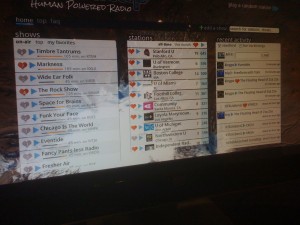I’m always immersed in the world of college radio, but the past few weeks have taken my college radio immersion to another level, with back-to-back college radio conferences consuming my schedule. First up was the CMJ Music Marathon in New York City, followed by the College Broadcasters, Inc. (CBI) conference in Orlando, Florida. Although both conferences featured panels focused on the “college radio crisis” and “saving college radio,” I came away from each experience feeling energized and optimistic about the state of college radio. Today’s New York Times article, “College Radio Heads: Off the Dial,” captures a bit of that positive college radio vibe, as it highlights the passionate people behind college radio.
As I learned at CMJ and CBI, the “crisis” isn’t top of mind for most college radio DJs. At the beginning of the “Saving College Radio” panel at CMJ on October 20th, moderator Ken Freedman of WFMU asked the audience how many people were afraid their stations would be sold. Only a few hands were raised. A similar situation occurred during CBI’s “The College Radio Crisis (and How to Survive)” panel that I was on. When asked the same question, only a couple of hands were raised. Although only a small number of DJs expressed their fears publicly, a number of private conversations revealed that many college students are eager to fight for their stations’ futures.
It was inspiring to meet 18-year-old college radio DJs who care deeply about radio. Marissa Greenberg, music director of Pace University station WPUB, is only in her first year of college, yet is already a radio veteran, having served several years in management at her high school station. Similarly, Sean Martin, the General Manager of Wright State radio station WWSU in Dayton, Ohio, told me that he enjoys connecting with other college radio stations in his area. He regularly tours nearby stations and even created a Facebook group for “mid-west college radio nerds.” At CBI, I met staffers from University of South Carolina station WUSC who are thinking about planning some events that would serve to bring together stations from across their region. I also caught up with DJs from WRFL who do one of the most ambitious events that I’ve seen come of out college radio. Each year they organize and host the 3-day Boomslang music festival in Lexington, Kentucky across multiple venues.
Whereas today’s New York Times article seems to suggest that there’s tension between terrestrial radio and new technologies, I didn’t hear much of that talk at CBI or CMJ. No matter what type of station one volunteers at, the primary conversations seemed to circle around keeping DJs motivated and working, gaining more listeners, and keeping one’s station afloat. Clearly online tools and changing platforms are important, with numerous sessions at each conference dissecting social media, webcasting, mobile, and HD radio. But all of these tools were just one part of maintaining a successful radio station. That point is essential at terrestrial stations that need to also maintain a close watch on FCC regulations. With that in mind, many sessions at CBI provided tips for complying with FCC rules, preparing for EAS tests, and preparing for an FCC inspection.
In subsequent posts, I’ll recap some of the specifics from CMJ and CBI, including suggestions for stations in crisis provided on the “saving college radio”-themed panels at each event.



